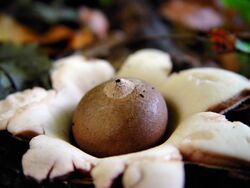Biology:Geastrales
| Geastrales | |
|---|---|

| |
| Geastrum triplex | |
| Scientific classification | |
| Domain: | Eukaryota |
| Kingdom: | Fungi |
| Division: | Basidiomycota |
| Class: | Agaricomycetes |
| Subclass: | Phallomycetidae |
| Order: | Geastrales K.Hosaka & Castellano (2007)[2] |
| Family: | Geastraceae Corda (1842)[1] |
| Type genus | |
| Geastrum Pers. (1801)
| |
| Genera | |
|
Geasteroides | |
| Synonyms[3] | |
|
Sphaerobolaceae J.Schröter (1889) | |
Geastrales is an order of gasterocarpic basidiomycetes (fungi) that are related to Cantharellales. The order contains the single family Geastraceae, which includes the "earthstars" formerly placed in Lycoperdales, or Phallales.[4][5]
Approximately 64 species are classified in this family, divided among eight genera, including Geastrum, Myriostoma and Sphaerobolus. Sphaerobolus species are known as "shotgun fungus" or "cannonball fungus". They colonize wood-based mulches and may throw black, sticky, spore-containing globs onto nearby surfaces.[6][7]
The fruiting bodies of several earthstars are hygroscopic: in dry weather the "petals" will dry and curl up around the soft spore sac, protecting it. In this state, often the whole fungus becomes detached from the ground and may roll around like a tumbleweed. Once mature, their exoperidium splits into a variable number of rays, which give Geastrum their visible star shape. The exoperidial rays are there to protect the endoperidial body and orchestrate spore dispersal.[8] In wetter weather, the "petals" moisten and uncurl; some even curl backward lifting the spore sac up. This allows rain or animals to hit the spore sac so, emitting spores when enough moisture is present for them to germinate and establish.
References
- ↑ Corda ACJ. (1842) (in la). Icones fungorum hucusque cognitorum. 5. Prague: J.G. Calve. pp. 1–92 (see p. 25).
- ↑ "Molecular phylogenetics of the gomphoid-phalloid fungi with an establishment of the new subclass Phallomycetidae and two new orders". Mycologia 98 (6): 949–959. 2006. doi:10.3852/mycologia.98.6.949. PMID 17486971.
- ↑ Kirk et al. 2008, p. 648
- ↑ Ainsworth & Bisby's Dictionary of the Fungi (9th ed.). CABI Bioscience. 2001. p. 205. ISBN 978-0-85199-377-5.
- ↑ Kirk, PM; Cannon, PF; Minter, DW; Stalpers, JA (2008). Dictionary of the Fungi (10th ed.). CAB International. p. 274. ISBN 9780851998268.
- ↑ Lehman, RD. (1985). "Black spots on houses—an insect or disease problem?". Penn Dept Agric Bur Pl Ind, Reg Hort 11: 15–16.
- ↑ Brantley, EA; Davis, DD; Kuhns, LJ. (2001). "Biological control of the artillery fungus, Sphaerobolus stellatus, with Trichoderma harzianum and Bacillus subtilis". Journal of Environmental Horticulture 19 (1): 21–23. doi:10.24266/0738-2898-19.1.21.
- ↑ Kuhar, F., Castiglia, V., & Papinutti, L. (2013). Geastrum species of the La Rioja province, Argentina. Mycotaxon, 122, 145-156. https://doi.org/10.5248/122.145
External links
- "Geastrales K. Hosaka & Castellano". Atlas of Living Australia. https://bie.ala.org.au/species/urn:lsid:indexfungorum.org:names:501522.
Wikidata ☰ {{{from}}} entry
 |

